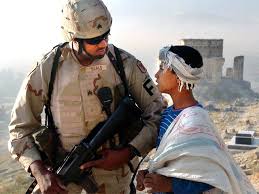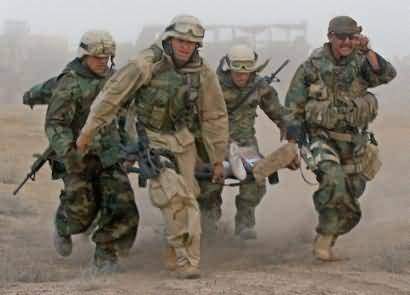The sounds of battle echo across a desolate stretch of land just east
of Bagram Air Base, America's biggest base in Afghanistan. As it turns
out, it's just battle practice.




"Training exercises on
our big weapons to include our small arms," explains Sergeant 1st Class
Steve Cunningham, of the 381st Military Police Unit. "Just put some ammo
down range. The Afghan people let us do this to make sure our weapons
stay functional for future missions."
He says rehearsals like
this help his troops keep their skills sharp, adding that they're skills
U.S. troops need to keep Afghans safe.
But villagers living
around the East River Range couldn't disagree more -- they argue U.S.
military exercises here are putting them in danger.
"Kids wander around and
touch what they find," says Wali Muhammad Kuchi, a nomadic shepherd who
is sitting across the road watching soldiers fire volleys of rounds into
the mountainside. "These kids, they don't know what is and isn't full
of explosives."
A handful of boys
standing around him are waiting for the soldiers to leave. They'll
scavenge for left over metal casings and fragments to sell for much
needed cash for their families.
One boy tells us one kilogram, or about 2.2 pounds, of scrap metal will earn him roughly 150 Afghanis, or $3.
Wali Muhammad lost a leg
and an arm to Soviet landmines in the 1980s, and he worries for the
safety of his 13 year-old son, Esakhil -- one of the boys who will soon
be out in the range searching for metal.
According to Mohammed Sediq Rashid, Chief of Operations of the Mine Action Coordination Centre
of Afghanistan (or MACCA), at least 12 civilians from villages
surrounding the range area have been maimed by unexploded ordnance, or
UXOs, in the last four years. At least one was killed.
The shepherds are also
at risk. They graze their sheep on slopes littered with bullets,
grenades, and in a recent case, an anti-aircraft rocket, according to
the U.S. military.
In a frayed cloth tent
next to the range, we find 17 year-old Abdul Rahman. He winces from pain
as he tells us how he lost part of his left arm.
"We are nomads. We take
our herds to the mountain site for feeding. I saw something there,"
describes Abdul Rahman. "When I picked it up and then hit it with a
stone it exploded."
His father, Zayar Gul,
recounts how he rushed his son to nearby Bagram Air Base for emergency
treatment. He says they were turned away by local guards at the gate. A
U.S. military official at the base said he wasn't aware of the case.
Abdul Rahman was
eventually taken to the Kabul Emergency Surgical Center, and then
transferred to an eye hospital to save his sight. Four weeks after the
explosion, he's still wearing sunglasses to protect his injured eyes.
The 17-year-old also
lost part of his other arm in a similar explosion several years ago. He
believes that in both incidents he was hurt by unexploded U.S. ordnance.
As Gul describes what happened to his son, his anger grows.
"It wasn't just
something thrown from the sky. If it wasn't for the Americans doing
their military exercises here, why would my son have been blown up?"
Gul's leg was severed by a Soviet era landmine, but he says it's U.S. forces who are now sowing destruction.
"We can't do any other
kind of work," says Gul, "We don't have houses and we can't go to the
cities. But they, the Americans, have made this place like fire for us."
If it wasn't for the Americans doing their military exercises here, why would my son have been blown up?
Afghan shepherd Zayar Gul
Afghan shepherd Zayar Gul
All along the 20
kilometer (12.4 mile) stretch of flat terrain at East River Range is
wide open land, with very little to indicate there's any danger. Fencing
is nonexistent, and the few signs there warning that this area is a
firing range are in faded English. For a largely illiterate population
that speaks mostly Dari and Pashto, it's almost impossible for them to
understand their lives are at risk.
Three decades of
successive wars made Afghanistan one of the most heavily mined countries
in the world. But now, UXOs account for three times as many casualties
as mines -- and most of them are children, according to MACCA.
United Nations estimates
that roughly 10 million landmines still remain in Afghanistan. Most of
them are Soviet made, the deadly legacy left over from Afghanistan's war
with that country.
But these days, Mohammad
Sediq Rashid, MACCA's Chief of Operations says U.S. forces need to
fully recognize their responsibility -- and that to a degree, they have
failed in their duty to protect Afghan civilians.
"They should do
something to make sure that the civilians are protected after the war is
finished or after the training is finished," says Rashid.
Bagram's Deputy Garrison
Commander, Michael Hartman, is in charge of the range. He acknowledges
the U.S. military needs to do more at various sites throughout the
country, and says he empathizes with the local population.
"I'm a grandfather and
I'm hearing these stories of kids out there getting injured," he says.
"I have seven grandkids. My oldest is 13, my youngest is seven. So, in
addition to being a concerned grandparent, I know how I'd feel if my
kids got injured. I think we have to do a better job of marking."
To that end, he says the
military plans to soon place big concrete blocks about 200 meters apart
on the flat terrain part of the range -- and intends to mark them with
the international symbols that indicate a minefield.
"We think using those markings, red on one side, white on the other, is something they'll recognize," Hartman explains.
"The second part of that
would be to have a warning or safety warnings," adds Hartman,
"'unexploded ordnance or impact area' -- written in there in three
languages -- English, Pashto and Dari -- because that's the languages
that are understood here."
He adds that people in
the area know it's a firing range, "but usually economics drive them to
go out there and scavenge metals."
As members of the 381st
Military Police Unit finish up their exercises, they pick up spent shell
casings from the road. Cunningham says his unit does the right thing.
"I'd say that we're really big on picking up the metal that we lay down," he explains.
"We pick up the trash and we pick up after ourselves. We brought it with us, we're taking it back with us."
I know how I'd feel if my kids got injured. I think we have to do a better job of marking.
Michael Hartman, Bagram Deputy Garrison Commander
Michael Hartman, Bagram Deputy Garrison Commander
Still, these troops
won't venture far beyond the road because they know there are decades
worth of explosive remnants of war out there.
But Wali Muhamad has other worries.
"The remains from the
foot solders aren't that dangerous," he says, "it's the things that are
dropped first from the helicopters -- those things are very dangerous
and lots of people have lost body parts because of that."
The range is used to
test fire everything from 40mm grenades to 2.75-inch rockets fired by
helicopters, all the way up to Hellfire missiles, says Hartman. 20mm
rounds are fired off A-10 jets, and 30mm rounds are fired off the Apache
helicopters.
We asked what posed the
greatest risk to civilians in the area. Hartman said that while he's not
an explosive ordnance disposal expert, it's "usually the 40mm rounds,
40mm grenades that are usually fired with a shoulder, a rifle, Mark 19,
or some other weapons system."

Casualty reports from
East River Range started coming in to MACCA in 2008. Rashid says it's
been tough to communicate with the Americans. Ahead of the troop
withdrawal from Afghanistan by the end of 2014, he's worried about UXOs
that will be left behind by coalition forces.
"We need to know the
possible location of unexploded ordnance," says a somewhat frustrated
Rashid. "We need to know the possible areas that are affected by
improvised explosive devices. We need to have information ... before the
international community forces leave -- they should pass it on to us so
that the mine action program of Afghanistan is aware of these problems
and able to address those legacies of the war in the years to come."
The U.S. military says it is aware of the dangers.
"We're at war," explains
Hartman, "and you know, war is an inherently dangerous business. And we
try to mitigate that danger by consolidating those routine, so to
speak, firing and expenditure of weapon munitions into a controlled area
as best we can."
Hartman, who arrived in
Afghanistan in February, says he's not sure exactly what will be done to
clean up UXOs from the East River Range, but says a concerted effort is
now being made to minimize future casualties.
But for Abdul Rahman and
others living close to the range, it's too late. They say this is their
land, and they have nowhere else to go.
No comments:
Post a Comment